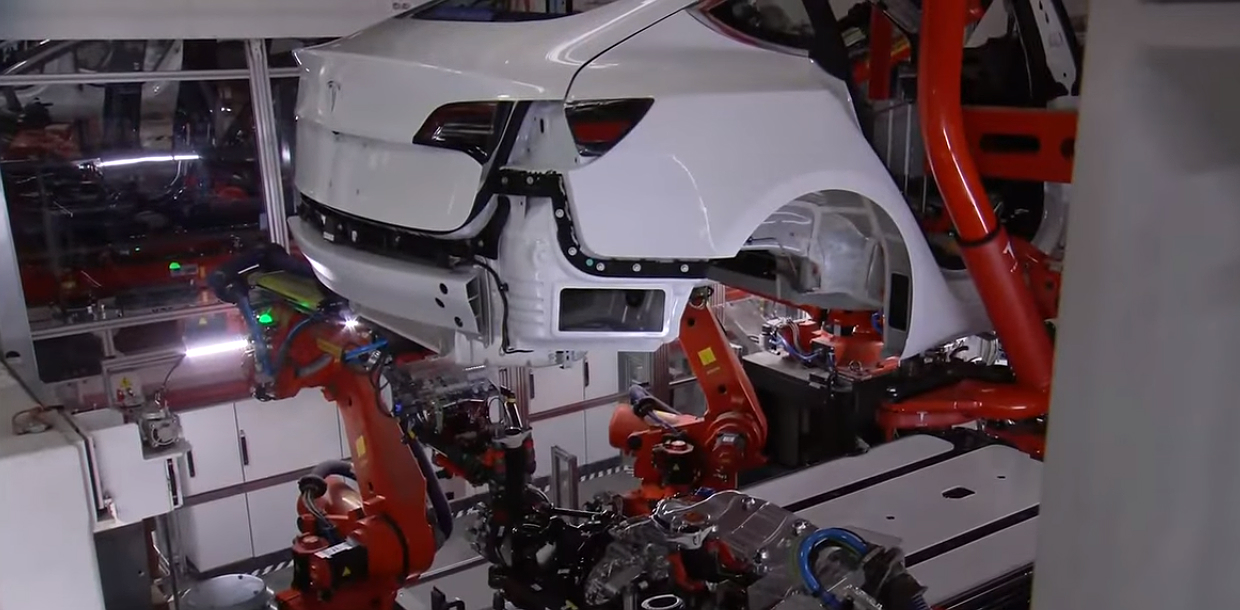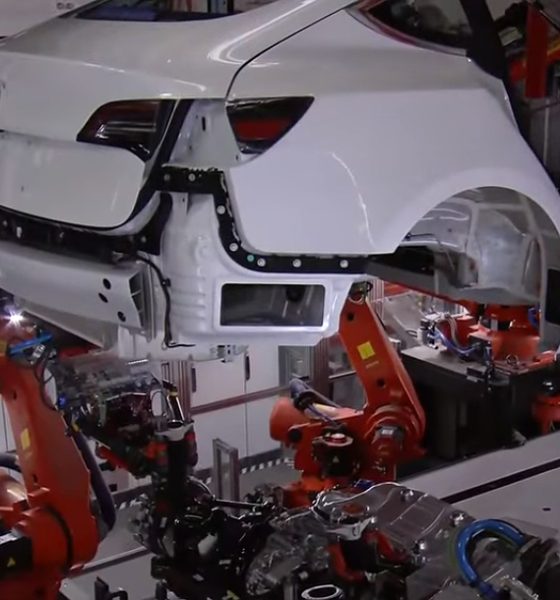

News
Tesla Model 3 production is reportedly closing in on 4,000 per week
After the scheduled shutdown in April, the Tesla Model 3 production line is reportedly closing in on 4,000 vehicles per week.
The figures were first reported by Tesla Motors Club member bkmxp100d, a Tesla owner who stated that they were informed of the numbers by a friend working at the Fremont factory. The production shutdown last month reportedly had a positive effect on the pace of the Model 3 line, allowing the electric car maker to manufacture 4,290 Model 3 in 7 days, with a peak of 638 vehicles in 24 hours. The next scheduled shutdown for the Model 3 line is reportedly scheduled for the May 26-May 27 weekend as well.
While the numbers provided by the Tesla enthusiast appear to be optimistic speculations, the ramp to 4,000 Model 3 per week is roughly in line with the estimates of Bloomberg‘s online tracker. Currently, the tracker shows that Tesla is pacing towards a rate of 4,000 vehicles per week. Other members of the forum community also stated that their own sources from Tesla are reporting Model 3 production figures hovering slightly below or just above the ~4,000/week range. VIN registrations from last week were encouraging as well, with Tesla filing more than 8,000 VINs in a single week.
Bloomberg‘s Model 3 tracker as of 05/14/18. [Credit: Bloomberg]
During the first-quarter earnings call, Elon Musk mentioned that what he is “most excited about” was the rapid increase in the production output of the Model 3 line. Musk even noted that the Model 3’s peak hours already correspond to 5,000 vehicles per week.
“The thing I’m most excited about is the rapid increase in output. We got just in the last 24 hours at the Gigafactory managed to achieve a sustained rate of over 3,000 packs per day – sorry, per week, and actually reached a peak hour with extrapolated outward would be a rate of about 5,000 cars per week.”
“We also saw enormous improvement in zone four of module production. This, I should point out, is a fully automated zone, and we’re able to also achieve sustained rates of 3,000 vehicles a week. So, we’re actually slightly ahead in factory module and pack production than expected. And with some work at the Fremont vehicle plant, primarily in the general assembly area, I’m confident we will very soon exceed the 3,000 mark in Fremont.”
Responding to an article published by Ars Technica about how the company’s issues with its machinery were reflective of GM’s struggles back in the 1980s, Musk recently tweeted that the company is currently working on the Model 3 line’s “worst production choke points.” Musk also noted that a “Hackathon” — a fast-paced programming session that sometimes lasts for days — is currently ongoing, in order to address bottlenecks in the Model 3 line.
Fair criticism, but we’re fixing it fast. Hackathon going on right now to fix 2 worst robot production chokepoints. Looks promising.
— Elon Musk (@elonmusk) May 14, 2018
Since the first-quarter earnings call, Elon Musk has doubled down on his rhetoric about the Model 3’s production numbers and Tesla’s profitability by the third or fourth quarter of 2018. Just a couple of days after the earnings call, Musk stated that the “short burn of the century” is about to come.
“Oh and uh short burn of the century coming soon. Flamethrowers should arrive just in time. It will be next level. These are really big numbers,” Musk tweeted.
Musk also took the battle to the company’s short-sellers, buying 27,097 Telsa shares, which correspond to an investment of nearly $10 million in TSLA.

Elon Musk
Elon Musk and Tesla AI Director share insights after empty driver seat Robotaxi rides
The executives’ unoccupied tests hint at the rapid progress of Tesla’s unsupervised Robotaxi efforts.

Tesla CEO Elon Musk and AI Director Ashok Elluswamy celebrated Christmas Eve by sharing personal experiences with Robotaxi vehicles that had no safety monitor or occupant in the driver’s seat. Musk described the system’s “perfect driving” around Austin, while Elluswamy posted video from the back seat, calling it “an amazing experience.”
The executives’ unoccupied tests hint at the rapid progress of Tesla’s unsupervised Robotaxi efforts.
Elon and Ashok’s firsthand Robotaxi insights
Prior to Musk and the Tesla AI Director’s posts, sightings of unmanned Teslas navigating public roads were widely shared on social media. One such vehicle was spotted in Austin, Texas, which Elon Musk acknowleged by stating that “Testing is underway with no occupants in the car.”
Based on his Christmas Eve post, Musk seemed to have tested an unmanned Tesla himself. “A Tesla with no safety monitor in the car and me sitting in the passenger seat took me all around Austin on Sunday with perfect driving,” Musk wrote in his post.
Elluswamy responded with a 2-minute video showing himself in the rear of an unmanned Tesla. The video featured the vehicle’s empty front seats, as well as its smooth handling through real-world traffic. He captioned his video with the words, “It’s an amazing experience!”
Towards Unsupervised operations
During an xAI Hackathon earlier this month, Elon Musk mentioned that Tesla owed be removing Safety Monitors from its Robotaxis in Austin in just three weeks. “Unsupervised is pretty much solved at this point. So there will be Tesla Robotaxis operating in Austin with no one in them. Not even anyone in the passenger seat in about three weeks,” he said. Musk echoed similar estimates at the 2025 Annual Shareholder Meeting and the Q3 2025 earnings call.
Considering the insights that were posted Musk and Elluswamy, it does appear that Tesla is working hard towards operating its Robotaxis with no safety monitors. This is quite impressive considering that the service was launched just earlier this year.
Elon Musk
Starlink passes 9 million active customers just weeks after hitting 8 million
The milestone highlights the accelerating growth of Starlink, which has now been adding over 20,000 new users per day.

SpaceX’s Starlink satellite internet service has continued its rapid global expansion, surpassing 9 million active customers just weeks after crossing the 8 million mark.
The milestone highlights the accelerating growth of Starlink, which has now been adding over 20,000 new users per day.
9 million customers
In a post on X, SpaceX stated that Starlink now serves over 9 million active users across 155 countries, territories, and markets. The company reached 8 million customers in early November, meaning it added roughly 1 million subscribers in under seven weeks, or about 21,275 new users on average per day.
“Starlink is connecting more than 9M active customers with high-speed internet across 155 countries, territories, and many other markets,” Starlink wrote in a post on its official X account. SpaceX President Gwynne Shotwell also celebrated the milestone on X. “A huge thank you to all of our customers and congrats to the Starlink team for such an incredible product,” she wrote.
That growth rate reflects both rising demand for broadband in underserved regions and Starlink’s expanding satellite constellation, which now includes more than 9,000 low-Earth-orbit satellites designed to deliver high-speed, low-latency internet worldwide.
Starlink’s momentum
Starlink’s momentum has been building up. SpaceX reported 4.6 million Starlink customers in December 2024, followed by 7 million by August 2025, and 8 million customers in November. Independent data also suggests Starlink usage is rising sharply, with Cloudflare reporting that global web traffic from Starlink users more than doubled in 2025, as noted in an Insider report.
Starlink’s momentum is increasingly tied to SpaceX’s broader financial outlook. Elon Musk has said the satellite network is “by far” the company’s largest revenue driver, and reports suggest SpaceX may be positioning itself for an initial public offering as soon as next year, with valuations estimated as high as $1.5 trillion. Musk has also suggested in the past that Starlink could have its own IPO in the future.
News
NVIDIA Director of Robotics: Tesla FSD v14 is the first AI to pass the “Physical Turing Test”
After testing FSD v14, Fan stated that his experience with FSD felt magical at first, but it soon started to feel like a routine.

NVIDIA Director of Robotics Jim Fan has praised Tesla’s Full Self-Driving (Supervised) v14 as the first AI to pass what he described as a “Physical Turing Test.”
After testing FSD v14, Fan stated that his experience with FSD felt magical at first, but it soon started to feel like a routine. And just like smartphones today, removing it now would “actively hurt.”
Jim Fan’s hands-on FSD v14 impressions
Fan, a leading researcher in embodied AI who is currently solving Physical AI at NVIDIA and spearheading the company’s Project GR00T initiative, noted that he actually was late to the Tesla game. He was, however, one of the first to try out FSD v14.
“I was very late to own a Tesla but among the earliest to try out FSD v14. It’s perhaps the first time I experience an AI that passes the Physical Turing Test: after a long day at work, you press a button, lay back, and couldn’t tell if a neural net or a human drove you home,” Fan wrote in a post on X.
Fan added: “Despite knowing exactly how robot learning works, I still find it magical watching the steering wheel turn by itself. First it feels surreal, next it becomes routine. Then, like the smartphone, taking it away actively hurts. This is how humanity gets rewired and glued to god-like technologies.”
The Physical Turing Test
The original Turing Test was conceived by Alan Turing in 1950, and it was aimed at determining if a machine could exhibit behavior that is equivalent to or indistinguishable from a human. By focusing on text-based conversations, the original Turing Test set a high bar for natural language processing and machine learning.
This test has been passed by today’s large language models. However, the capability to converse in a humanlike manner is a completely different challenge from performing real-world problem-solving or physical interactions. Thus, Fan introduced the Physical Turing Test, which challenges AI systems to demonstrate intelligence through physical actions.
Based on Fan’s comments, Tesla has demonstrated these intelligent physical actions with FSD v14. Elon Musk agreed with the NVIDIA executive, stating in a post on X that with FSD v14, “you can sense the sentience maturing.” Musk also praised Tesla AI, calling it the best “real-world AI” today.








